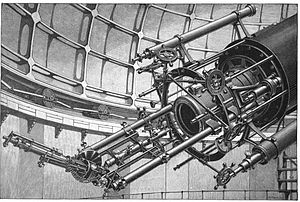
Back مطيافية فلكية Arabic Espectroscopia astronómica AST Espectroscòpia astronòmica Catalan Astrospektroskopie German Espectroscopia astronómica Spanish Astrospektroskoopia Estonian طیفسنجی نجومی Persian Spectroscopie astronomique French Espectroscopia astronómica Galician खगोलीय स्पेक्ट्रमिकी Hindi

Astronomical spectroscopy is the study of astronomy using the techniques of spectroscopy to measure the spectrum of electromagnetic radiation, including visible light, ultraviolet, X-ray, infrared and radio waves that radiate from stars and other celestial objects. A stellar spectrum can reveal many properties of stars, such as their chemical composition, temperature, density, mass, distance and luminosity. Spectroscopy can show the velocity of motion towards or away from the observer by measuring the Doppler shift. Spectroscopy is also used to study the physical properties of many other types of celestial objects such as planets, nebulae, galaxies, and active galactic nuclei.